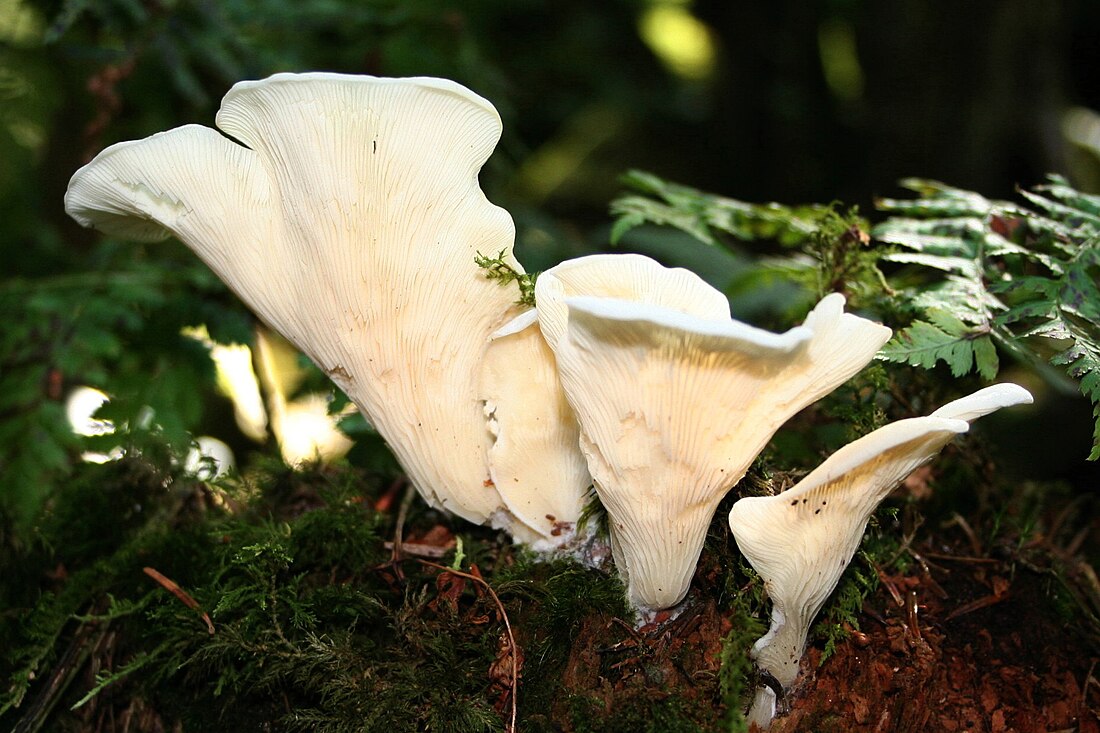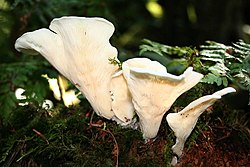Top Qs
Timeline
Chat
Perspective
Pleurocybella porrigens
Species of fungus in the family Marasmiaceae From Wikipedia, the free encyclopedia
Remove ads
Pleurocybella porrigens, also known as the angel wing, is a species of fungus in the family Phyllotopsidaceae. It medium-sized fruit bodies are whitish and fan-shaped. It is a wood-decay fungus on conifer wood and is widespread in temperate forests of the Northern Hemisphere. It is suspected of being potentially deadly poisonous.
Remove ads
Taxonomy
Synonyms for the species include Pleurotus porrigens, Phyllotus porrigens, Dendrosarcus porrigens, Pleurotellus porrigens, and Nothopanus porrigens.
Description
The mushroom species is distinguished by its fruit bodies, pure white when young and sometimes yellowing with age.[2] The cap is about 4–9 centimetres (1+1⁄2–3+1⁄2 in) wide, shaped like a petal or a fan.[3][2] The stipe is either very short or completely absent, and the flesh has a faint but pleasant smell.[4] The gills are crowded, and decurrent if a stipe is present.[2] The flesh is thin and fragile compared to the oyster mushrooms (Pleurotus ssp.).[5] The spore print is white.[3]
Remove ads
Distribution and habitat
The species is widespread in temperate forests of the Northern Hemisphere.[6] In North America, it can be found from August to November.[3][7] It is a white-rot wood-decay fungus on conifer wood, particularly hemlock (genus Tsuga).[5]
Potential toxicity
Summarize
Perspective

P. porrigens was once generally regarded as edible,[8] though bland.[2] As of 2011, it is a suspect in two outbreaks in Japan involving fatal encephalopathy. Most victims had preexisting kidney disorders.[9][10][11]
The first incident occurred in September and October 2004[12] across nine prefectures in Japan, documenting the sickening of 59 people and the eventual death of 17.[9] Most of those who died had preexisting liver problems and the average age of those affected was 70.[9] Death occurred between 13 and 29 days after the onset of symptoms, which occurred at most three weeks after consumption of the species.[12]
The second incident occurred in 2009, when a 65-year-old man who had been on hemodialysis died from acute encephalopathy after eating P. porrigens.[9]
The mechanism of action for the toxicity of P. porrigens has not been definitively established,[9] but several possibilities have been suggested. It has been demonstrated that P. porrigens contains an unusual amino acid which is toxic to the brain cells of rats in cell culture studies,[9][13] but it has not yet been possible to definitively determine that this was the cause of the fatal encephalopathies.[9] Other mechanisms have been suggested for P. porrigens's apparent toxicity, including the possibility that the fungus may contain toxic levels of cyanide salts.[14]
Remove ads
See also
References
External links
Wikiwand - on
Seamless Wikipedia browsing. On steroids.
Remove ads

